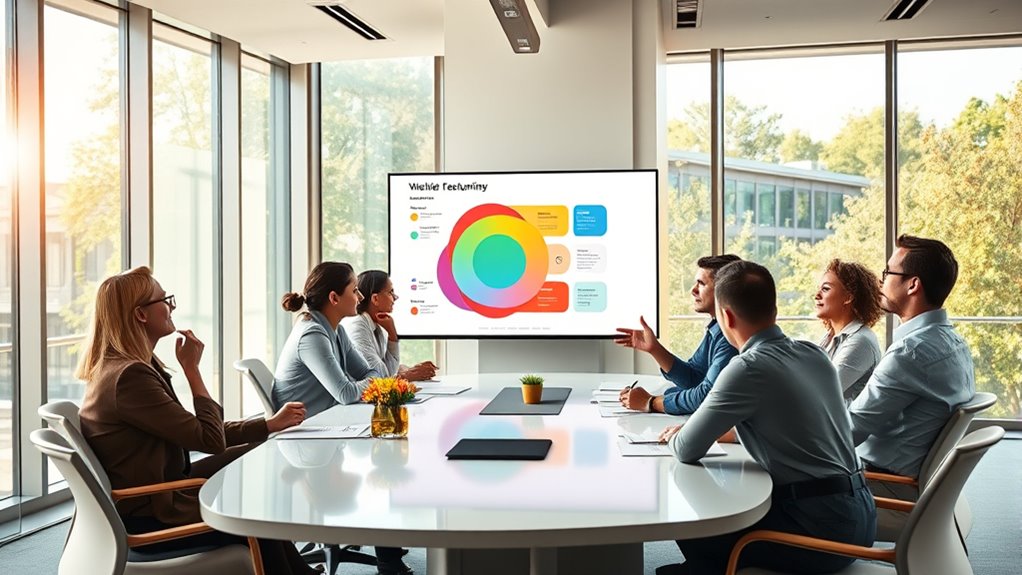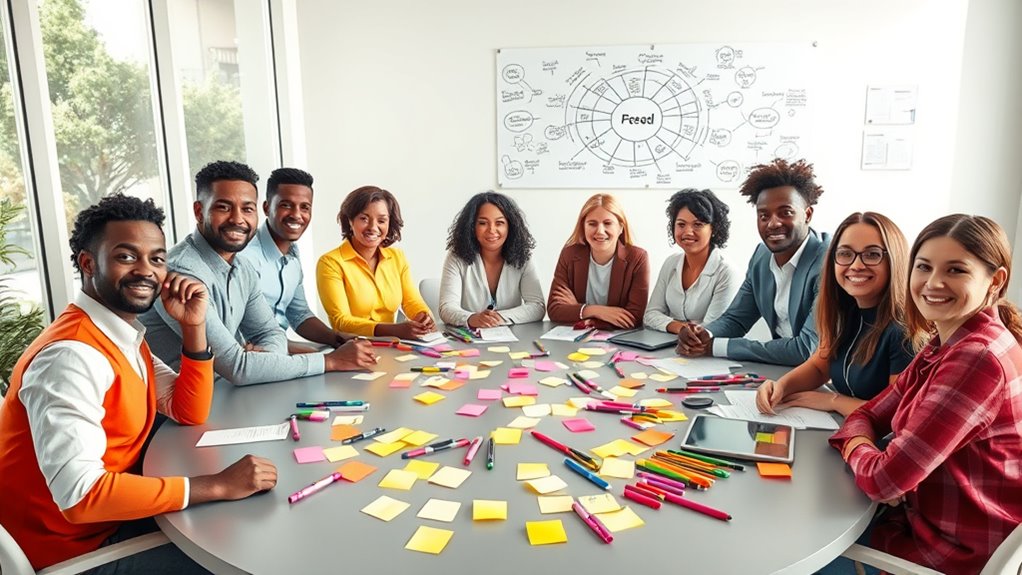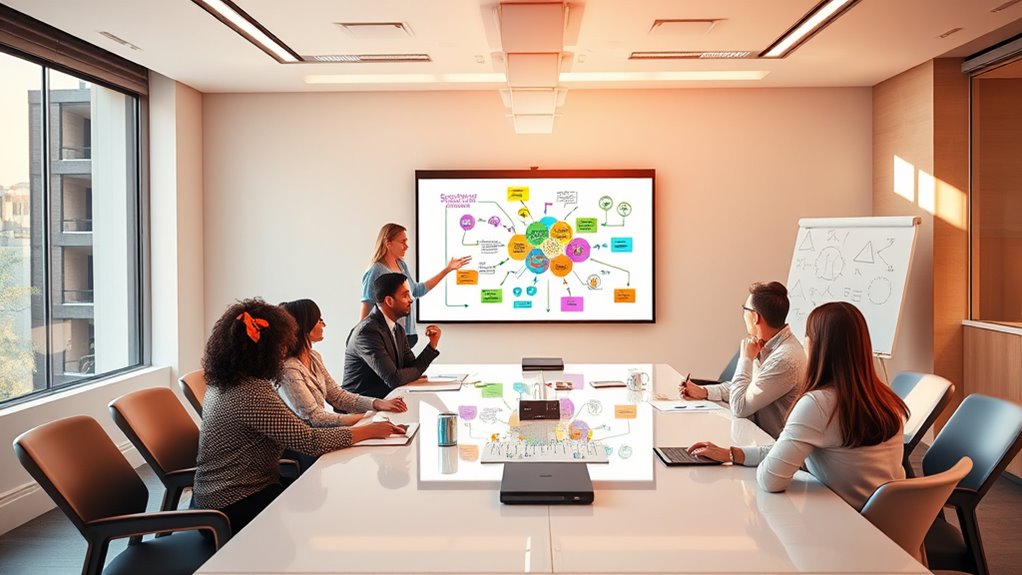To break bias and defeat groupthink, adopt structured ideation techniques like mind mapping, SCAMPER, and diverse brainstorming sessions. These methods help you challenge assumptions, include varied perspectives, and promote critical thinking amidst social pressures. Establish a safe, inclusive environment using digital tools and clear rules to guarantee everyone’s voice is heard. By systematically questioning and diversifying ideas, you can foster more innovative solutions. Keep exploring further to discover how to implement these strategies effectively.
Key Takeaways
- Implement diverse ideation techniques like mind mapping and SCAMPER to challenge habitual thinking patterns.
- Foster an inclusive environment with clear ground rules and anonymous input to reduce social conformity and biases.
- Use digital collaboration tools to ensure equal participation and real-time idea sharing across all team members.
- Incorporate structured processes and constraints to systematically explore alternatives and prevent groupthink.
- Regularly review and adjust benchmarks to promote continuous improvement and sustain innovative thinking.
Understanding the Pitfalls of Groupthink

Groupthink occurs when the desire for harmony and conformity within a group overrides critical thinking and individual judgment. When everyone aims to agree, you might ignore evidence that challenges the group’s consensus, falling into confirmation bias. This bias causes you to seek out information that supports your existing beliefs, making it harder to see alternative viewpoints. Social conformity pressures also push you to align with the group’s opinions, even if they seem flawed. As a result, you might suppress doubts or objections, believing that disagreement could disrupt harmony. Recognizing these pitfalls helps you understand why groupthink happens and how it stifles innovation and honest debate. Avoiding these tendencies requires conscious effort to question assumptions and encourage diverse perspectives. Additionally, being aware of group dynamics—such as social influence and peer pressure—can help you identify and counteract tendencies toward conformity.
The Power of Structured Ideation Techniques

Structured ideation techniques harness the power of systematic processes to generate diverse and innovative ideas. By following clear frameworks, you reduce the influence of cognitive biases that often limit creative thinking, such as confirmation bias or fixation. These methods introduce creative constraints that challenge your usual thought patterns, encouraging fresh perspectives. For example, techniques like mind mapping or SCAMPER force you to explore alternatives within defined boundaries, breaking free from habitual assumptions. This structured approach not only enhances idea quality but also guarantees everyone’s voice is heard, minimizing groupthink. Furthermore, understanding relationships – personality tests can help tailor ideation processes to better suit team dynamics and individual strengths. Ultimately, it helps you access your team’s collective creativity, producing more inventive solutions while systematically avoiding the pitfalls of biased thinking.
Challenging Assumptions With Deliberate Questioning

Have you ever accepted an assumption without questioning whether it truly holds? Challenging assumptions requires deliberate questioning to uncover hidden biases and challenge ingrained thinking. When you question assumptions, you boost bias awareness, helping you recognize automatic judgments that limit innovation. Instead of accepting things at face value, ask why things are the way they are, what alternatives exist, and whether any biases influence your perspective. This process encourages critical thinking and opens space for new ideas. By actively questioning assumptions, you break free from groupthink and foster a culture of curiosity. Remember, bias often operates silently, so deliberate questioning is your key to revealing and overcoming these subconscious influences, leading to more objective, creative solutions. Additionally, understanding projector technology can help you make more informed decisions and challenge prevailing stereotypes about audiovisual equipment.
Employing Diverse Perspectives to Broaden Horizons

Why is it essential to incorporate diverse perspectives when tackling problems? Because perspective diversity brings fresh insights that challenge your assumptions and reveal blind spots. By engaging with individuals from different backgrounds, you enhance your cultural intelligence, which helps you understand and respect varied viewpoints. This approach broadens your horizons, enabling more innovative solutions and reducing groupthink. When you seek out diverse perspectives, you tap into a richer pool of ideas, fostering creativity and resilience. Recognizing the value of different cultural experiences and ways of thinking allows you to approach problems more holistically. Additionally, understanding vetted – ID Times helps you evaluate the credibility of various sources and viewpoints, further enriching your decision-making process. Ultimately, embracing perspective diversity not only elevates your problem-solving but also creates an environment where all voices contribute meaningfully, leading to better, more inclusive decisions.
Facilitating Inclusive and Equitable Idea Generation

To foster truly inclusive and equitable idea generation, you must actively create spaces where all voices feel valued and empowered to contribute. Prioritize inclusive participation by encouraging diverse team members to share their perspectives without fear of judgment. Guarantee equitable access to resources, platforms, and opportunities so everyone can participate fully. Recognize and address barriers that might hinder some voices from being heard, whether they stem from language differences, cultural norms, or power dynamics. By fostering an environment of openness and respect, you help build trust, making it easier for everyone to contribute ideas. Understanding groupthink and its impact can help prevent conformity and promote diverse thinking. This approach not only enriches the creative process but also ensures that the resulting solutions are more balanced, innovative, and representative of the entire group’s insights.
Tools and Methods to Implement Structured Ideation

To implement structured ideation effectively, you can use various tools and methods tailored to your team’s needs. Brainstorming techniques help generate diverse ideas, while facilitated sessions keep discussions focused and inclusive. Digital collaboration tools enable remote participation and streamline idea sharing across distances. Incorporating analytical thinking into your process can further enhance the assessment and refinement of ideas.
Brainstorming Techniques Overview
Effective brainstorming hinges on using the right tools and methods to foster structured ideation. Techniques like mind mapping help you visualize ideas and their connections, making complex concepts easier to develop and refine. It encourages free-flowing thinking while maintaining organization, reducing the risk of groupthink. A brain dump is another powerful method, allowing you to quickly jot down all ideas without judgment or filtering. This raw input can then be structured and analyzed, revealing new perspectives. Both techniques promote a free exchange of ideas, breaking down mental barriers and biases. Incorporating predictive modeling into your sessions can help anticipate potential outcomes and guide the ideation process more effectively. By integrating these tools into your sessions, you create a more inclusive environment where diverse thoughts can flourish, leading to innovative solutions that might otherwise be overlooked.
Facilitated Idea Sessions
How can you guarantee that idea generation sessions remain focused and productive? Facilitated idea sessions are essential tools for bias mitigation and fostering innovation leadership. By guiding discussions with a skilled facilitator, you assure that all voices are heard and dominant personalities don’t overshadow quieter participants. This structure helps prevent groupthink and encourages diverse perspectives. Techniques like round-robin sharing, time-boxed brainstorming, and anonymous input collection keep sessions on track and reduce bias influences. Additionally, setting clear objectives and ground rules enhances focus. As an innovation leader, your role is to create a safe environment where participants feel empowered to share ideas without fear of judgment. Facilitated sessions enable you to harness collective creativity while systematically addressing bias, resulting in more innovative and inclusive outcomes. Understanding store hours and planning around them can also provide insights into operational efficiencies and customer engagement strategies.
Digital Collaboration Tools
Have you considered how digital collaboration tools can streamline structured ideation sessions? These tools enable seamless virtual brainstorming, making it easier to gather diverse ideas without physical boundaries. Collaborative platforms like Miro, MURAL, or Microsoft Teams facilitate real-time input, ensuring everyone’s voice is heard and bias is minimized. They help you organize ideas systematically, assign tasks, and track progress effortlessly. By leveraging these tools, you create an inclusive environment where silent participants can contribute equally, reducing groupthink. Digital collaboration platforms also allow for anonymous input, which can further break down social hierarchies and biases. Additionally, understanding the importance of structured ideation can enhance your ability to generate innovative solutions effectively. Overall, integrating these tools into your ideation process promotes transparency, diversity of thought, and more innovative solutions—crucial for breaking bias and fostering effective teamwork.
Measuring Success and Sustaining Creative Growth

Measuring success and maintaining creative growth require ongoing effort and clear benchmarks. You should establish innovative metrics that go beyond traditional performance indicators, capturing both quantitative and qualitative progress. Use these metrics to evaluate how well new ideas are evolving and how effectively your team is overcoming biases that hinder innovation. Growth benchmarks help you set realistic goals and track improvements over time, ensuring continuous development. Regularly review these benchmarks to identify areas for adjustment and celebrate milestones. Remember, sustained creative growth isn’t just about hitting targets; it’s about fostering an environment where innovation thrives consistently. By combining innovative metrics with clear growth benchmarks, you create a feedback loop that sustains momentum and keeps your ideas fresh and impactful. Incorporate nutrient retention assessments to ensure your ideas stay as effective as the fresh vegetables in a cold-pressed juice.
Frequently Asked Questions
How Can Organizations Maintain Structured Ideation Over Time?
You can maintain structured ideation over time by regularly addressing cultural barriers that hinder open idea sharing. Encourage diverse perspectives and foster an inclusive environment. Align incentives so everyone sees value in contributing creatively. Consistently reinforce the importance of structured processes and feedback loops. By doing this, you guarantee that innovation remains a core part of your organization, preventing stagnation and promoting continuous improvement and collaboration.
What Are Common Challenges in Implementing Structured Ideation?
Did you know that 70% of teams struggle with implementing structured ideation? You might face common challenges like overcoming brainstorming pitfalls and originality barriers. These hurdles can make it hard to sustain innovative thinking over time. To succeed, you need clear processes and a culture that encourages diverse ideas. Without addressing these issues, your organization risks stagnation and missed opportunities for creative solutions.
How Does Technology Enhance Structured Ideation Processes?
Technology enhances structured ideation by enabling AI facilitation, which guides your team through idea generation objectively. Data analytics help you identify patterns and insights from large inputs, ensuring you don’t overlook valuable perspectives. With these tools, you streamline the process, reduce biases, and foster diverse, innovative ideas. You can collaborate more effectively, make data-driven decisions, and break free from groupthink, ultimately leading to more creative and impactful solutions.
Can Structured Ideation Be Adapted for Remote Teams?
Imagine a virtual brainstorm that’s so powerful, it feels like a lightning storm across the internet! Yes, structured ideation easily adapts for remote teams through virtual collaboration tools. You can facilitate asynchronous brainstorming sessions, where ideas flow without everyone being online at once. This method keeps everyone engaged, sparks creativity, and overcomes time zone barriers, making remote collaboration as dynamic and effective as in-person sessions.
What Role Does Leadership Play in Overcoming Groupthink?
Leadership influence is vital in overcoming groupthink because you hold decision-making authority and shape team culture. Your role involves encouraging diverse opinions, challenging ideas respectfully, and fostering an environment where everyone feels safe to speak up. By actively promoting critical thinking and inclusive discussions, you help prevent conformity pressures, ensuring better decision making. Your leadership sets the tone for openness, making it easier for your team to break free from groupthink.
Conclusion
By adopting structured ideation, you can combat the 61% of teams that admit to falling into groupthink, leading to less innovative outcomes. When you challenge assumptions and include diverse perspectives, you open up fresh ideas and foster inclusivity. Embrace tools that promote equitable collaboration, and watch your creativity flourish. Remember, breaking bias isn’t just about better ideas — it’s about creating a culture where everyone’s voice drives meaningful progress.








